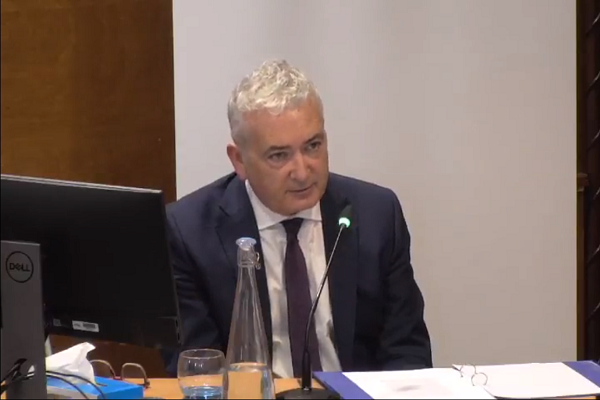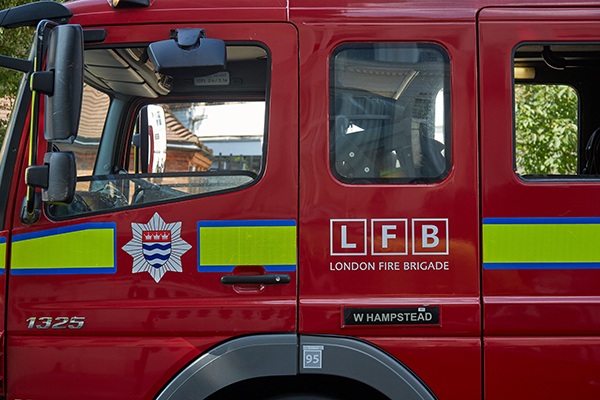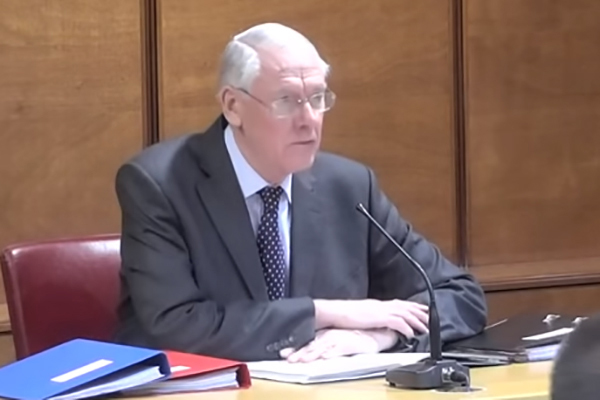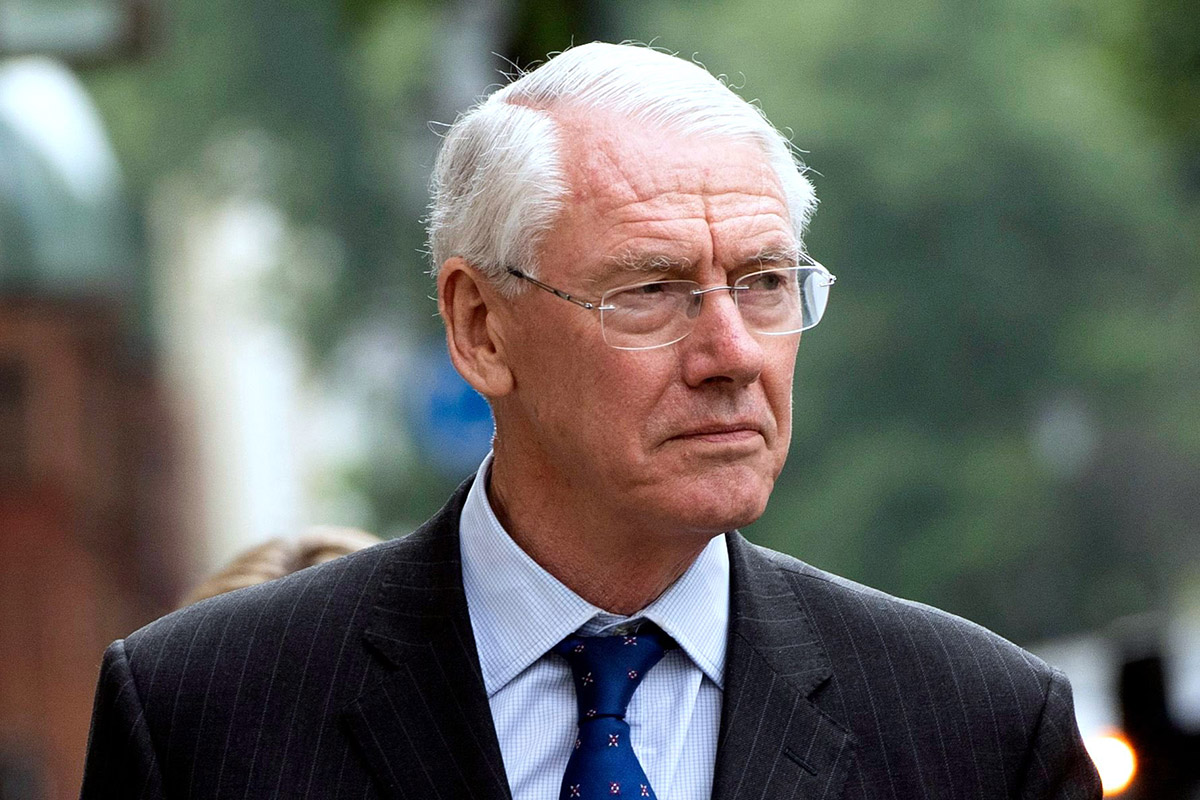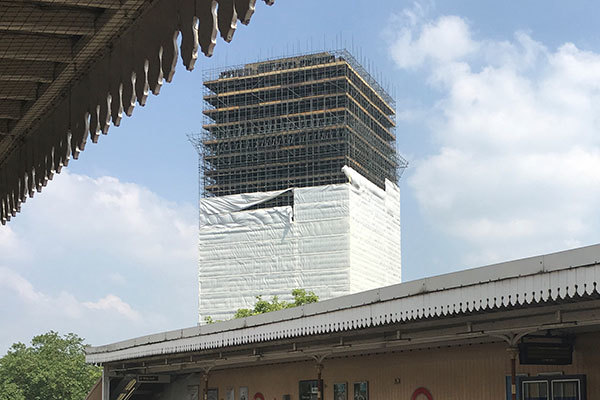KCTMO chief criticised for ‘passive role’ and ‘ineffective leadership’ on night of Grenfell fire
The report from phase one of the public inquiry into the Grenfell Tower blaze has criticised the former chief executive of the company that managed the tower, calling his leadership “ineffective” and saying his attitude throughout the fire was “essentially detached”.
Robert Black, the chief executive of Kensington and Chelsea Tenant Management Organisation (KCTMO), was singled out for criticism by Sir Martin Moore-Bick’s report into the events on the night of the fire, which killed 72 people.
Speaking at the inquiry in November, Mr Black said KCTMO had “no role” in responding to the fire and described the organisation’s role as a “spare part” during the recovery effort.
KCTMO managed 9,000 homes across Kensington and Chelsea at the time of the fire. Following the fire, the Royal Borough of Kensington and Chelsea (RBKC) took back control of its housing stock from the company in December 2017.
The organisation was not listed as a responder in RBKC’s emergency contingency plan, so was not subject to the corresponding duties. Its management plan with the council also did not oblige it to have emergency plans and procedures in place.
Sir Martin wrote that while he recognised that the RBKC contingency plan did not require Mr Black to act in a formal capacity, which could have contributed to his lack of leadership, this did not explain why he did not oversee any of his staff in their roles and did not get involved in collecting information about survivors.
An example given by the report of Mr Black’s “detached attitude” on the night was his failure to ensure that important emails were forwarded to the local authority liaison manager (LALO) and the London Fire Brigade (LFB).
This included an email that included an up-to-date list of Grenfell residents, which was sent to him at 6.24am and 6.38am.
However, Mr Black did not pass on the information to the LFB and LALO until 7.56am. He said the delay was because the LFB did not ask for the information and he assumed a colleague would pass it on.
Sir Martin said Mr Black’s actions demonstrated an “almost casual assumption” that someone else would take responsibility for what needed to be done and described it as an “unjustifiable failure” to appreciate the importance to the LFB of the list of residents.
Mr Black became KCTMO’s chief executive in 2009 but resigned from the organisation in January 2018.
KCTMO must remain in existence as a legal entity throughout the inquiry so it can be held to account. In January, Inside Housing revealed RBKC would spend £500,000 this year to keep it running.
In response to the report, Mr Black: “My thoughts will always be with the victims, survivors and their families. I cannot begin to imagine the impact this appalling tragedy has had on so many people.
“In terms of the report itself, this is clearly a time for reflection and learning and I will be considering its findings carefully.
“Looking ahead, phase two of the inquiry will be hugely significant, and I will be helping with that in any way I can.”
The inquiry also found that the building’s emergency plan was 15 years out of date and failed to reflect the make-up of the tower after the 2016 refurbishment, which saw cladding installed.
It contained the wrong number of flats and inaccurate details about the number of vulnerable residents in the block.
Sir Martin said that phase two of the inquiry would explore why such a potentially important document about the state of the property “remained obsolete" for so many years.
Scrutiny of Mr Black and KCTMO’s actions on the night came in a section of the report looking into the response of the Metropolitan Police, ambulance service, RBKC and KCTMO.
The report said the failures of the police, ambulance service, council and TMO did not lead to any deaths or injuries, but the inquiry believed several important lessons could still be learned for future major disasters in London.
One deficiency was the fact the police, fire brigade and ambulance service all declared a ‘major incident’ without telling each other or the council, which meant the need for a co-ordinated joint response was not appreciated early enough.
The inquiry also reported that RBKC’s contingency management plan was found to be “partly ineffective” and depended on information from KCTMO.
The Grenfell Tower Inquiry recommendations: phase one
Picture: Getty
Evacuation
There were no plans to evacuate Grenfell Tower available. Sir Martin Moore-Bick, chair of the Grenfell Inquiry, recommended:
- The development of national guidelines for carrying out partial or total evacuations of high-rise buildings – including protecting fire access routes and procedures for evacuating people who require assistance
- Fire services develop policies for partial or total evacuation of high rises
- Owner and manager be required to draw up and keep under review evacuation plans, with copies provided to local fire and rescue services and placed in an information box on the premises
- All high-rise buildings be equipped with facilities to enable the sending of an evacuation signal to the whole or a selected part of the building
- Owners and managers be required by law to prepare personal evacuation plans for residents who may struggle to do so personally, with information about them stored in the premise’s information box
- All fire services be equipped with smoke hoods to help evacuate residents down smoke-filled stairs
Fire doors
Sir Martin said it is apparent that “ineffective fire doors allowed smoke and toxic gases to spread through the building more quickly than should have been possible”, and that missing self-closers played an important role. He recommended:
- An urgent inspection of fire doors in all buildings containing separate dwellings, whether or not they are high rises
- A legal requirement on the owner or manager of these buildings to check doors at least every three months to ensure self-closing devices are working effectively
Sprinklers
Noting the recommendation from the coroner investigating the Lakanal House fire that the use of sprinklers be encouraged, Sir Martin said that some of his experts had “urged me to go a step further and to recommend such systems be installed in all existing high-rise buildings”.
He said that sprinklers have “a very effective part to play” in an overall scheme of fire safety, but that he had not yet heard evidence about their use. He said that he could make no recommendations at this stage, but that he would consider the matter in phase two.
Internal signage
Floor numbers in the tower were not clearly marked and markings were not updated when the floor numbers changed following the refurbishment. Sir Martin said that all high-rise buildings should have floors clearly marked in a prominent place, which would be visible in low light or smoky conditions. Given that not all residents of Grenfell could read fire information signs, he said this should now be provided in a means that all residents can understand.
Use of combustible materials
Sir Martin said the original fire in the kitchen was no more than an ordinary kitchen fire that spread to the cladding because of “the proximity of combustible materials to the kitchen windows” – such as the uPVC frames.
He said this is a matter that “it would be sensible” for owners of other high-rise buildings to check.
He said he would “add his voice” to those who have expressed concern about the slow pace of removal work for more than 400 other tall buildings in England with aluminium composite material cladding.
A total of 97 buildings in the social housing sector and 168 in the private sector have not yet seen the work complete. Sir Martin said the work must be completed “as vigorously as possible”.
He said particular attention should be paid to decorative features, given the crucial role played by the architectural crown at Grenfell in spreading the fire around the building.
Given the decision to ban combustible materials on new buildings last year, he did not call for further restrictions on their use.
Fire service: knowledge and understanding of materials in high-rise buildings
Sir Martin raised concern that junior firefighters were not aware of the danger of cladding fires, and that the London Fire Brigade (LFB) was unaware of the combustible materials used to refurbish Grenfell Tower.
He therefore recommended:
- That the owner and manager of every high-rise building is required to provide details of external walls and the materials used to the local fire service, and inform them of any changes
- To ensure that fire services personnel at all levels understand the risk of cladding fires
Plans
Sir Martin said that a lack of plans did not “unduly hamper” fire services at Grenfell, as each floor was laid out in the same way. However he warned that another building with a more complex layout could pose problems. He recommended:
- That owners and managers of high-rise buildings are required by law to provide paper and electronic versions of building plans of all high rises to local fire services
- To ensure the building contains a premises information box, including a copy of floor plans
Lifts
Firefighters were unable to use a mechanism that allows them to take control of the lifts on the night of the fire, hampering their progress and meaning residents could still use the lifts, “in some cases with fatal consequences”. Sir Martin therefore recommended:
- That the owner and manager of every high-rise building be required by law to carry out regular inspections of any lift required for use by firefighters and the mechanism that allows them to take control of it
Section 7(2)(d) of the Fire and Rescue Services Act
The judge was concerned that inspections of the tower by the fire service before the fire were not enough to meet their responsibilities under this act. He recommended:
- A revision of the guidance for the London Fire Brigade, and training for all officers above the rank of crew manager in inspecting high-rise buildings
Co-operation between emergency services
There was a lack of communication between each emergency service at Grenfell, with each declaring a major incident at different times without telling each other. Sir Martin recommended several changes to ensure better communication in the future.
Personal fire protection
Sir Martin decided not to issue a recommendation that individual flats be provided with fire extinguishers or fire blankets, noting concerns that this could encourage residents to fight fires rather than escape and call the emergency services.
Communication between the control room and the incident commander
While guidance calls for a “free flow” of information between a fire service control room and the commanding officer on the ground, that often does not happen. Sir Martin therefore recommended:
- A review of policies by the LFB on this matter, including training for all officers who could serve as incident commanders and senior control room officers.
- A dedicated communications link between the senior officer and the incident commander
Emergency calls
Even allowing for the pressure of the night, Sir Martin said that fire survival guidance calls were not handled in an “appropriate or effective way”. He therefore recommended:
- Amending of policies and training for control room officers
- That all fire services develop policies for multiple fire survival guidance calls
- Electronic systems to record and display calls
- A policy for managing a transition from ‘stay put’ to ‘get out’ and training for call handlers in delivering this change of advice
Command and control
Sir Martin said firefighters too frequently “acted on their own initiative”, resulting in a duplication of effort. He called for better policies to ensure:
- Better control of training and deployment
- Information is obtained from crews after they have deployed
Equipment
Sir Martin made some recommendations for improvements to fire service equipment, including radios and the command support system.
Testing and certification of materials
Sir Martin said this is an issue that will be investigated “early in phase two”, along with an assessment of “whether the current guidance on how to comply with the building regulations is sufficiently clear and reliable”.
He also said the inquiry would investigate whether a ‘prescriptive’ regime of regulation was necessary. However, as these issues have not yet been examined by the inquiry he did not make any recommendations.
